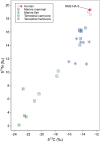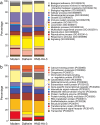Palaeoproteomic investigation of an ancient human skeleton with abnormal deposition of dental calculus
- PMID: 38467689
- PMCID: PMC10928219
- DOI: 10.1038/s41598-024-55779-y
Palaeoproteomic investigation of an ancient human skeleton with abnormal deposition of dental calculus
Abstract
Detailed investigation of extremely severe pathological conditions in ancient human skeletons is important as it could shed light on the breadth of potential interactions between humans and disease etiologies in the past. Here, we applied palaeoproteomics to investigate an ancient human skeletal individual with severe oral pathology, focusing our research on bacterial pathogenic factors and host defense response. This female skeleton, from the Okhotsk period (i.e., fifth to thirteenth century) of Northern Japan, poses relevant amounts of abnormal dental calculus deposition and exhibits oral dysfunction due to severe periodontal disease. A shotgun mass-spectrometry analysis identified 81 human proteins and 15 bacterial proteins from the calculus of the subject. We identified two pathogenic or bioinvasive proteins originating from two of the three "red complex" bacteria, the core species associated with severe periodontal disease in modern humans, as well as two additional bioinvasive proteins of periodontal-associated bacteria. Moreover, we discovered defense response system-associated human proteins, although their proportion was mostly similar to those reported in ancient and modern human individuals with lower calculus deposition. These results suggest that the bacterial etiology was similar and the host defense response was not necessarily more intense in ancient individuals with significant amounts of abnormal dental calculus deposition.
© 2024. The Author(s).
Conflict of interest statement
The authors declare no competing interests.
Figures




Similar articles
-
Comparison of Periodontal Bacteria of Edo and Modern Periods Using Novel Diagnostic Approach for Periodontitis With Micro-CT.Front Cell Infect Microbiol. 2021 Sep 20;11:723821. doi: 10.3389/fcimb.2021.723821. eCollection 2021. Front Cell Infect Microbiol. 2021. PMID: 34616690 Free PMC article.
-
Microbial differences between dental plaque and historic dental calculus are related to oral biofilm maturation stage.Microbiome. 2019 Jul 6;7(1):102. doi: 10.1186/s40168-019-0717-3. Microbiome. 2019. PMID: 31279340 Free PMC article.
-
Multi-omic detection of Mycobacterium leprae in archaeological human dental calculus.Philos Trans R Soc Lond B Biol Sci. 2020 Nov 23;375(1812):20190584. doi: 10.1098/rstb.2019.0584. Epub 2020 Oct 5. Philos Trans R Soc Lond B Biol Sci. 2020. PMID: 33012227 Free PMC article.
-
Routine scale and polish for periodontal health in adults.Cochrane Database Syst Rev. 2018 Dec 27;12(12):CD004625. doi: 10.1002/14651858.CD004625.pub5. Cochrane Database Syst Rev. 2018. PMID: 30590875 Free PMC article.
-
Dental calculus: recent insights into occurrence, formation, prevention, removal and oral health effects of supragingival and subgingival deposits.Eur J Oral Sci. 1997 Oct;105(5 Pt 2):508-22. doi: 10.1111/j.1600-0722.1997.tb00238.x. Eur J Oral Sci. 1997. PMID: 9395117 Review.
References
MeSH terms
Substances
Grants and funding
LinkOut - more resources
Full Text Sources
Molecular Biology Databases
Miscellaneous

